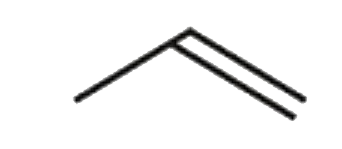What will the major product of the following :
C2H5ONa+CH3−CH3∣C∣CH3−Cl→?
CH3CH3∣C∣C2H5−OCH3
CH3−C∣CH3=CH3
CH2=CH2
CH3−CH3∣C∣CH3−OC2H5
The correct Answer is:B
To determine the major product of the reaction between sodium ethoxide (C2H5ONa) and the given tertiary halide (CH3)2C(Cl)CH2CH3, we will follow these steps:
Step 1: Identify the Reaction Type
The reaction involves a tertiary halide and a strong base (sodium ethoxide). In this case, we need to consider the potential pathways: substitution (SN1 or SN2) and elimination (E1 or E2).
Hint: Tertiary halides typically favor elimination reactions over substitution due to steric hindrance.
Step 2: Analyze the Tertiary Halide
The given halide is a tertiary halide, which means that the carbon bonded to the halogen (Cl) is attached to three other carbon atoms. This structure makes it less favorable for SN2 reactions because of steric hindrance.
Hint: Tertiary halides do not undergo SN2 reactions due to steric hindrance.
Step 3: Determine the Elimination Pathway
Since SN2 is not viable, we consider elimination reactions. Given that sodium ethoxide is a strong base, it will promote E2 elimination. In the absence of a solvent, E1 elimination is also not favored.
Hint: Strong bases promote E2 eliminations, especially in the absence of solvents.
Step 4: Identify the β-Hydrogen
In E2 elimination, we need to remove a β-hydrogen that is anti to the leaving group (Cl). The β-hydrogens are the hydrogens on the carbon adjacent to the carbon with the halogen.
Hint: Look for β-hydrogens that can be eliminated in an anti-periplanar fashion with respect to the leaving group.
Step 5: Perform the Elimination
In this case, we can remove a β-hydrogen from the CH2 group adjacent to the carbon with the Cl. This will lead to the formation of a double bond between the carbon that had the Cl and the carbon from which the hydrogen was removed.
Hint: The elimination will result in the formation of a double bond between the two carbons involved.
Step 6: Write the Major Product
The major product of this reaction will be an alkene. The product will have the structure of a double bond formed between the carbon that had the Cl and the adjacent carbon from which the hydrogen was removed.
The final product will be:
- Product: CH2=C(CH3)CH2CH3 (2-methylpropene)
Hint: The major product is often the most stable alkene formed from the elimination reaction.
Conclusion
The major product of the reaction between sodium ethoxide and the given tertiary halide is 2-methylpropene (CH2=C(CH3)CH2CH3), formed through an E2 elimination mechanism.
The reaction involves a tertiary halide and a strong base (sodium ethoxide). In this case, we need to consider the potential pathways: substitution (SN1 or SN2) and elimination (E1 or E2).
The given halide is a tertiary halide, which means that the carbon bonded to the halogen (Cl) is attached to three other carbon atoms. This structure makes it less favorable for SN2 reactions because of steric hindrance.
Since SN2 is not viable, we consider elimination reactions. Given that sodium ethoxide is a strong base, it will promote E2 elimination. In the absence of a solvent, E1 elimination is also not favored.
In E2 elimination, we need to remove a β-hydrogen that is anti to the leaving group (Cl). The β-hydrogens are the hydrogens on the carbon adjacent to the carbon with the halogen.
In this case, we can remove a β-hydrogen from the CH2 group adjacent to the carbon with the Cl. This will lead to the formation of a double bond between the carbon that had the Cl and the carbon from which the hydrogen was removed.
The major product of this reaction will be an alkene. The product will have the structure of a double bond formed between the carbon that had the Cl and the adjacent carbon from which the hydrogen was removed.
- Product: CH2=C(CH3)CH2CH3 (2-methylpropene)
The major product of the reaction between sodium ethoxide and the given tertiary halide is 2-methylpropene (CH2=C(CH3)CH2CH3), formed through an E2 elimination mechanism.
Topper's Solved these Questions
- SAMPLE PAPER 04BOOK - EDUCART PUBLICATIONCHAPTER - SAMPLE PAPER 04EXERCISE - SECTION C
6 Videos
- SAMPLE PAPER 04BOOK - EDUCART PUBLICATIONCHAPTER - SAMPLE PAPER 04EXERCISE - SECTION C
6 Videos
- SAMPLE PAPER 02BOOK - EDUCART PUBLICATIONCHAPTER - SAMPLE PAPER 02EXERCISE - SECTION - C
6 Videos
- SAMPLE PAPER 05BOOK - EDUCART PUBLICATIONCHAPTER - SAMPLE PAPER 05EXERCISE - SECTION-C
6 Videos
Similar Questions
Knowledge Check
Major product of the following reaction will be
C2H5ONa+CH3−CH3∣C∣CH3−Cl→ACH3−CH3∣C∣CH3−OC2H5BCH3−C∣CH3=CH2CCH2=CH2DCH3−CH3∣C∣C2H5−OCH3The IUPAC name of CH3−CH3∣C∣CH3−CH=CH2
is -A2,2 - Dimethyl -3- butaneB2,2 - Dimethyl -4- penteneC3,3 - Dimethyl - 1- buteneD1 - HexeneWhat is the major product alkene formed in the following elimination?
CH3CH2CH2CH3∣N+∣CH3−CH3∣C∣CH3−CH3Δ−−→A B
B C
C D
D
The major product formed in the following reaction is :
CH3−CH3∣C∣CH3−C∣OHH−CH3concH2SO4−−−−−−→a few drops Major product
View SolutionIdentify the major product in the following reactions :
C6H5−CH2−H∣C∣Br−CH3Alc.KOH−−−−−→Δ?HBr−−→ ?
View SolutionThe major product of the following reaction is :
C6H5CH2−CH3∣C∣Br=CH2−CH3C2H5ONa−−−−−→C2H5OH
View SolutionThe major product of the following reaction is:
C6H5CH2−CH3∣C∣Br−CH2−CH3C2H5Na−−−−→C2H5OH
View SolutionThe major product formed in the following reaction is
CH3−CH3∣C∣H−CH2BrCH3O−−−−−→CH3OH
View Solution

